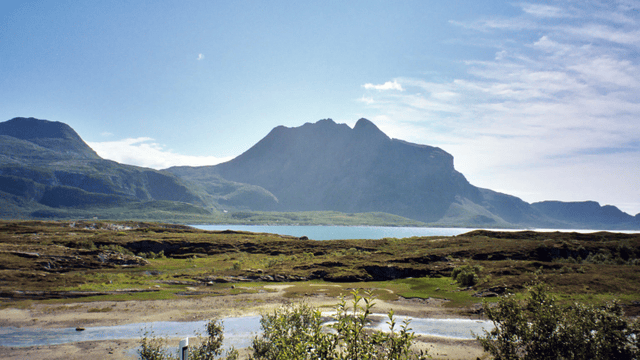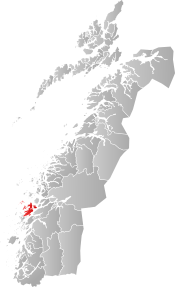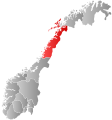Dønna

Dønna

Dønna kommune | |
|---|---|
Municipality | |
 Dønna within Nordland | |
| Coordinates:66°05′29″N 12°31′33″E [11] | |
| Country | Norway |
| County | Nordland |
| District | Helgeland |
| Established | 1 Jan 1962 |
| Administrative centre | Solfjellsjøen |
| Government | |
| • Mayor(2015) | John Erik Skjellnes Johansen (Ap) |
| Area | |
| • Total | 191.94 km2(74.11 sq mi) |
| • Land | 186.31 km2(71.93 sq mi) |
| • Water | 5.63 km2(2.17 sq mi) 2.9% |
| Area rank | 333 in Norway |
| Population (2018) | |
| • Total | 1,403 |
| • Rank | 358 in Norway |
| • Density | 7.5/km2(19/sq mi) |
| • Change(10 years) | -4.1% |
| Demonym(s) | dønnværing[1] |
| Time zone | UTC+01:00 (CET) |
| • Summer (DST) | UTC+02:00 (CEST) |
| ISO 3166 code | NO-1827 |
| Official language form | Bokmål |
| Website | donna.kommune.no [12] |
Data from Statistics Norway [13] | |
Dønna is a municipality in Nordland county, Norway. It is part of the Helgeland region. The administrative centre of the island municipality is the village of Solfjellsjøen. Other villages include Bjørn, Dønnes, Hestad, Sandåker, and Vandve. The main island of Dønna is connected to the neighboring municipality of Herøy to the south by the Åkviksundet Bridge.
The 192-square-kilometre (74 sq mi) municipality is the 333rd largest by area out of the 422 municipalities in Norway. Dønna is the 358th most populous municipality in Norway with a population of 1,403. The municipality's population density is 7.5 inhabitants per square kilometre (19/sq mi) and its population has decreased by 4.1% over the last decade.[2][3]
Dønna kommune | |
|---|---|
Municipality | |
 Dønna within Nordland | |
| Coordinates:66°05′29″N 12°31′33″E [11] | |
| Country | Norway |
| County | Nordland |
| District | Helgeland |
| Established | 1 Jan 1962 |
| Administrative centre | Solfjellsjøen |
| Government | |
| • Mayor(2015) | John Erik Skjellnes Johansen (Ap) |
| Area | |
| • Total | 191.94 km2(74.11 sq mi) |
| • Land | 186.31 km2(71.93 sq mi) |
| • Water | 5.63 km2(2.17 sq mi) 2.9% |
| Area rank | 333 in Norway |
| Population (2018) | |
| • Total | 1,403 |
| • Rank | 358 in Norway |
| • Density | 7.5/km2(19/sq mi) |
| • Change(10 years) | -4.1% |
| Demonym(s) | dønnværing[1] |
| Time zone | UTC+01:00 (CET) |
| • Summer (DST) | UTC+02:00 (CEST) |
| ISO 3166 code | NO-1827 |
| Official language form | Bokmål |
| Website | donna.kommune.no [12] |
Data from Statistics Norway [13] | |
General information
Municipal history
The municipality of Dønna was established on 1 January 1962 due to the work of the Schei Committee. The new municipality was created by merging these areas:
the municipality of Nordvik (population: 1,293)
the part of the municipality of Herøy on the southern tip of the island of Dønna (population: 19)
the part of the municipality of Nesna on the island Løkta (population: 80)
the majority of the municipality of Dønnes (population: 1,348), except for the part located on the island of Tomma.
The borders of Dønna municipality have not changed since that time.[4]
Name
The municipality is named after the island of Dønna (Old Norse: Dyn). The name is probably derived from the Norse verb dynja which means to "rumble" or "roar" (referring to the swell of the waves on the island).[5]
Coat of arms
The coat of arms was granted on 29 May 1981. The arms show a wave as a canting symbol for the municipality since the Norwegian word dønning means wave.[6]
Churches
The Church of Norway has one parish (sokn) within the municipality of Dønna. It is part of the Nord-Helgeland prosti (deanery) in the Diocese of Sør-Hålogaland.
| Parish (sokn) | Church Name | Location of the Church | Year Built |
|---|---|---|---|
| Dønna | Dønnes Church | Dønnes | 13th century |
| Hæstad Church | Hestad | 1912 | |
| Løkta Church | Sandåker | 1968 | |
| Nordvik Church | Nordvik | 1877 | |
| Vandve Church | Vandve | 1956 |
Economy
Much of the industry focuses on fishing, aquaculture, and fish processing. There is also some agriculture, tourism, and some public services.
Government
All municipalities in Norway, including Dønna, are responsible for primary education (through 10th grade), outpatient health services, senior citizen services, unemployment and other social services, zoning, economic development, and municipal roads. The municipality is governed by a municipal council of elected representatives, which in turn elect a mayor.[7] The municipality falls under the Alstahaug District Court and the Hålogaland Court of Appeal.
Municipal council
| Party Name | Name in Norwegian | Number of representatives | |
|---|---|---|---|
| Labour Party | Arbeiderpartiet | 6 | |
| Progress Party | Fremskrittspartiet | 1 | |
| Conservative Party | Høyre | 2 | |
| Socialist Left Party | Sosialistisk Venstreparti | 3 | |
| Local Lists | Lokale lister | 5 | |
| Total number of members: | 17 | ||
Geography

View from Dønnesfjellet, Dønna. The strandflaten lowland in the foreground and several islands with unique mountain formations visible in the distance
Dønna is located in Outer Helgeland which also consists of the municipalities of Leirfjord, Alstahaug, and Herøy. The municipality is made up of a large archipelago consisting of islands, islets, and reefs. The three largest islands in the municipality are Dønna, Løkta, and Vandve. The Åsværet islands (and the Åsvær Lighthouse) lie in the western part of the municipality. The island municipality is situated at the mouth of the Ranfjorden.
Notable residents
Anton Christian Bang, theologian and author
Steinar Bastesen, whaler and independent politician
Petter Dass, priest and poet (birthplace disputed: could also be in present-day Herøy)
Odd Eriksen, Labour politician
Roy Jacobsen, author (born in Oslo, but has lived periodically on Dønna)
Frederikke Tønder Olsen, feminist pioneer
Julius J. Olson, Minnesota Supreme Court justice
Ole Edvart Rølvaag, Norwegian-American author

